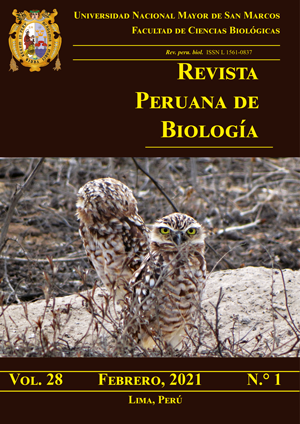Distribution and conservation of Cactaceae in Brazilian Seasonally Dry Tropical Forests: insights from floristic and phytosociological surveys
DOI:
https://doi.org/10.15381/rpb.v28i1.19745Keywords:
Caatinga, Cactaceae, crystalline substrate, sedimentary substrate, biodiversity, Seasonally dry tropical forests, SDTF, Brazil, floristic surveys, phytosociological surveysAbstract
Species lists available from floristic and phytosociological studies contain important information about species distributions that are useful for making biogeographical inferences and even to evaluate conservation status of species and ecosystems. In the case of the Caatinga, this information may contribute to challenging the pre-established idea that it is a homogeneous vegetation unit. The strong relation between the substrate and the plant assemblages of the Caatinga may characterise different types of vegetation. In this way, the objective of the present study is to evaluate whether differences in the distribution of Cactaceae relate to distinctive types of substrate (sedimentary and crystalline) as much in terms of floristic richness as species density. Concomitantly, we evaluated the conservation status of the Caatinga areas studied. To obtain the data, we undertook a bibliographic revision of floristic and phytosociological studies in the Caatinga and constructed a similarity matrix using the selected floristic studies in order to evaluate the relation among different areas of Caatinga. We found that 48 areas included Cactaceae species; 33 species distributed in 14 genera were recorded. Among these taxa, Cereus jamacaru was the species that presented the largest number of occurrences, appearing in 17 areas, followed by Pilosocereus gounellei (=Xiquexique gounellei), found in 11 studies, and Tacinga inamoena in 10. The grouping analysis resulted in the formation of 10 groups, with a remarkable relationship between species and soil type. There were differences in both the diversity and density of species related with the degree of conservation of the Caatinga, noticeable from the direct relationship between conservation and richness and, indirectly, between density and number of species.
Downloads
Downloads
Published
Issue
Section
License
Copyright (c) 2021 Silvana dos Santos Simões, Daniela C. Zappi, Grênivel Mota da Costa, Lidyanne Yuriko Saleme Aona

This work is licensed under a Creative Commons Attribution-NonCommercial-ShareAlike 4.0 International License.
AUTHORS RETAIN THEIR RIGHTS:
a. Authors retain their trade mark rights and patent, and also on any process or procedure described in the article.
b. Authors retain their right to share, copy, distribute, perform and publicly communicate their article (eg, to place their article in an institutional repository or publish it in a book), with an acknowledgment of its initial publication in the Revista Peruana de Biologia.
c. Authors retain theirs right to make a subsequent publication of their work, to use the article or any part thereof (eg a compilation of his papers, lecture notes, thesis, or a book), always indicating its initial publication in the Revista Peruana de Biologia (the originator of the work, journal, volume, number and date).


















